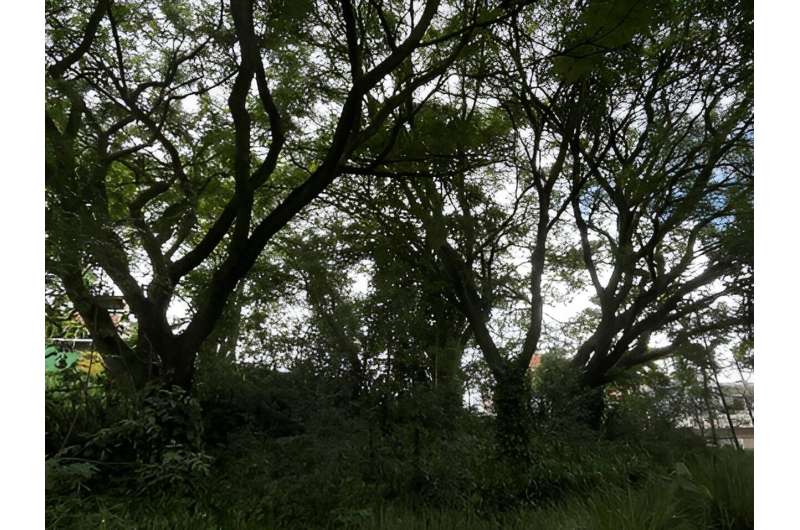This article has been reviewed according to Science X's editorial process and policies. Editors have highlighted the following attributes while ensuring the content's credibility:
fact-checked
trusted source
proofread
Common tree in São Paulo (Brazil) tolerates extreme drought and can help mitigate adverse effects of climate change

One of the three main tree species in São Paulo city, Brazil—the largest mega-city in the southern hemisphere—is the Tipuana (Tipuana tipu), also known as rosewood or tipu, a tall tree with a large spreading canopy. It is tolerant of extreme drought and can be considered an option to promote urban climate resilience, according to a paper published in the journal Urban Climate.
The study assessed the impact of the 2013–14 drought on trees in the city's streets and parks. The period was chosen because of the extreme drought that occurred in the summer, normally a rainy season when tree growth is vigorous.
Based on an analysis of the width of growth rings and processes relating to the carbon cycle, the authors concluded that photosynthesis by tipuana trees accelerates at high temperatures both in different urban microhabitats and during droughts, so that growth rates also rise even under restrictive weather conditions.
"We need cities to be increasingly resilient in the context of global warming. One way to get there is by planting trees and taking good care of existing trees. We must be pragmatic at times, choosing species capable of responding well to extreme weather so as not to lose the provision of ecosystem services, such as carbon capture and temperature regulation," said Giuliano Locosselli, a professor at the University of São Paulo's Center for Nuclear Energy in Agriculture (CENA-USP) and corresponding author of the paper.
Urban areas are expected to be home to 68% of the world population by 2050, according to a report issued by UN Habitat, with a rise of 2.2 billion in the number of city dwellers from current levels. On the other hand, cities are increasingly vulnerable to drought and extreme events owing to the shrinkage of permeable green areas and expansion of heat islands.
In light of these trends, discussion of resilient cities, territorial planning, preparedness, and rapid response and recovery in the face of climate challenges is growing. On May 5, in honor of World Environment Day, the Brazilian government published a decree that instituted Resilient Green Cities, a program to increase the resilience of cities nationwide in the face of climate change. It main aims are integrating policies and fostering sustainable practices to valorize the ecosystem services provided by urban green areas.
"The composition of urban plant cover including species that are resistant to different situations makes the entire city resilient to any extreme event. Our study adds an element that extends its biodiversity. We're also researching other native species," Locosselli said.
In partnership with Marcos Buckeridge, full professor at the Institute of Biosciences (IB-USP) and last author of the article, and a group of scientists at other institutions, Locosselli has conducted studies on nature-based solutions to mitigate the adverse effects of climate change and pollution by optimizing the ecosystem services provided by urban forests.
In one of these studies, using the tipuana tree as a model, they showed that air pollution stunts tree growth and restricts the environmental services trees provide.
Besides the tipuana tree, considered an exotic (non-native) species in São Paulo, the other most common tree species in the city are Ligustrum lucidum (glossy privet, a small tree or shrub that can reach a height of 3 m and bears white flowers) and Caesalpinia pluviosa (sibipiruna in Brazil, momoqui in Bolivia, reaching 28 m, with a rounded crown and yellow flowers). The number of trees lining public streets in São Paulo is estimated at some 652,000.
"There's always a very pertinent and important discussion about the need to cultivate native versus exotic species. Native species, which occur naturally, have a key cultural significance, and the environmental legislation contains incentives to plant and protect them. However, the urban environment is unique and we need to look for resilient alternatives," Locoselli said.
The characteristics of the urban environment that affect plant health include concrete structures, impervious soil, air pollution, and varying microclimates, with heat islands and the impact of global warming exacerbated by greenhouse gas emissions. The average temperature in São Paulo city is 4 °C higher than in the past.
The tipuana tree originated in Bolivia and northern Argentina, but it has been ubiquitous in São Paulo for over a century. The species can also be seen lining streets in North America, Europe, Asia, the Middle East and Australia.
Carbon isotope analysis
In the study, the scientists analyzed growth rings in street trees and park trees, focusing on δ13C (pronounced "delta C 13"), a measure of stable carbon isotopes that reflects processes relating to the carbon cycle. Tree rings help estimate the past variability of ecosystem services based on wood microdensity, hydraulic architecture, and carbon and oxygen isotopes, serving as a reliable proxy to assess physiological processes and development over time.
They fed the data into a regression tree, a type of algorithm often used in urban forest analysis as its output is easily interpreted to support decision-making. One of the results showed a rise of δ13C during the drought, boosting tipuana tree growth.
"Tipuana trees are part of São Paulo's heritage, and a purely negative view of exotic species can therefore be overhasty. We showed that these species can indeed be a valuable part of urban biodiversity. Having tipuana trees in the city is a significant advantage," Locosselli said.
It remains to be seen whether the species will be able to maintain its tolerance of water stress if a sequence of extreme events occurs, he added.
More information: Giuliano Maselli Locosselli et al, Stress-tolerant trees for resilient cities: Tree-ring analysis reveals species suitable for a future climate, Urban Climate (2024). DOI: 10.1016/j.uclim.2024.101964
Provided by FAPESP





















